
With the All-Ireland Gaelic football final nearly upon us, let’s take a look at the strategies around penalty kicks. For those not familiar with the game, a brief primer: Gaelic football is a 15 player-a-side field sport where the ball can be handled and carried somewhat similarly to rugby, but with positional play and kicking style more like soccer. Arguably, Aussie Rules is the closest counterpart to Gaelic football. In Gaelic, a single point is scored by kicking the ball over the crossbar – think ‘field goal’ in American football, or a ‘drop goal’ in rugby. A goal, which is worth three points, is scored when the ball is shot past the goalie into the net, like soccer. The All-Ireland final is the pinnacle of the Irish sporting calendar, played at the end of September each year in front of over 82,000 spectators in Croke Park in Dublin. Fans and players are born, not made in Gaelic games, because teams represent their counties in this amateur game rather than clubs or franchises.
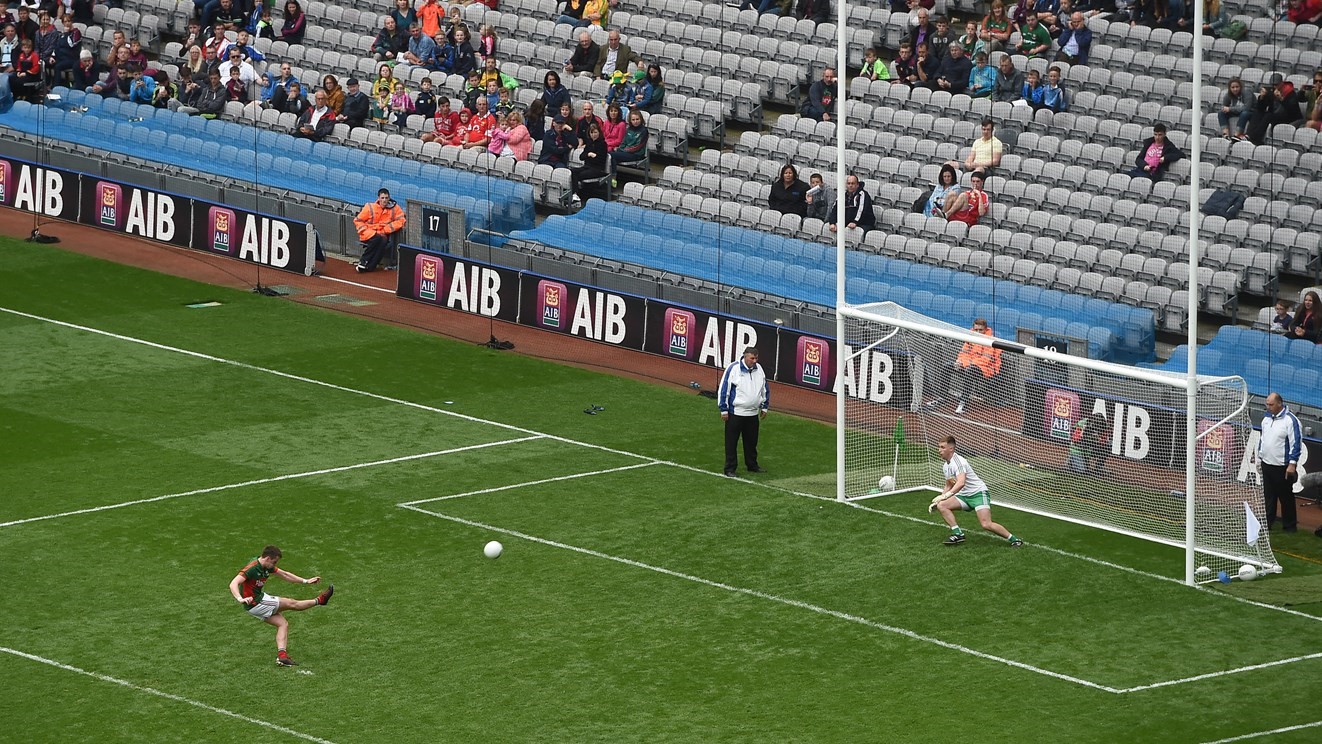
This year’s All-Ireland final, which features the county teams of Mayo and Dublin, will be a particularly intense affair in my house. I’m a proud Dublin man and my wife is a passionate Mayo woman. I am expecting much shouting at the TV with Mayo superstars Andy Moran and Aidan O’Shea being encouraged to “take your point,” Mayo defenders angrily implored to “stay on him,” and joyous exclamations of “lovely point!” when Mayo scores (though I’m hoping not too often). My wife is a long-suffering Mayo supporter who informs me that they are a very frustrating team to support. I guess she has a point, they’ve often been to the All-Ireland final but haven’t won since 1951. Of the seven All-Ireland finals that Mayo has reached since, they’ve lost them all. If the finals were coin flips, this would only happen once in 128 times. (If you’d like a very non-technical explanation of this, you can search “Mayo’s All-Ireland curse”.)
Now that I’ve given you some background, let’s look at which penalty-taking strategy maximises your expected point total – the Point Strategy (aiming for a point) or the Goal Strategy (aiming for a goal).
The Point Strategy is pretty likely to succeed. Shooting for a point from the penalty spot is such an easy shot for an intercounty footballer that I reckon they can score a point 95% of the time, but are highly unlikely to score a goal accidentally.((It is possible that you could go for a point and accidentally score a goal, but it’s unlikely. It’s also possible that you might go for a point and the goalie saves it. There are some other unlikely scenarios we could consider, but for simplicity we’re going to assume it’s about 0.95 expected value for the Point Strategy.)) So the expected value for this strategy is 0.95 times the value of the point, which is 1 plus zero times the value of the goal which is 3. This works out at 0.95 expected value in points of the Point Strategy.
The expected value in points of the Goal Strategy is slightly trickier to tease out. A quick Google search didn’t reveal how likely a kicker is to score a goal from a penalty in Gaelic football.((Even if we had the stats on how likely a goal is to be scored from a penalty, this still wouldn’t be enough information. Let me explain: What we want to know here is the probability of the penalty kicker scoring a goal given that they were trying to score a goal. This is the conditional probability so we would needs stats that not only told us how many goals were scored but also how often the kicker tried to score a goal. Imagine 100 penalties are taken. 50 of those lead to goals. We might be tempted to imply that the probability of successfully scoring a goal while trying to score a goal is 50%. However, if we were told that the kickers only tried for goals in 75 out of the 100 penalties, then in fact, the kicker was 50/75 to score a goal. This changes our estimate of the odds of successfully scoring a goal to 67% from the previous erroneous 50%.)) So instead, we’ll use stats from soccer because the penalty scenario is very similar across both sports. The main difference is that the width of the Gaelic football goal is 6.5 metres, slightly narrower than soccer at 7.32 metres wide. In soccer, penalties are scored roughly 77% of the time (this seems to vary based on various factors such as how tired the players are, but 77% is a broad average score rate) with penalties being saved 13% of the time, missed over the crossbar 4% of the time, and missed wide 6% of the time. The success rate for scoring a goal from a penalty shot in Gaelic is likely to be lower than soccer, given the narrower goal posts, but let’s try to use some logic to work out how much lower.
Some penalty kicking strategies (where to aim the ball) will be unaffected by the narrower Gaelic goals. But let’s take a strategy that definitely will be affected – aiming a foot inside the post to the left (or right, makes no difference). Taking this penalty kicking strategy, we can intuit that the success rate for these penalties in Gaelic will be lower than soccer, because, with the narrower goalposts in Gaelic, aiming a foot inside the post will leave the ball closer to the goalie and therefore more susceptible to being saved. Examining this strategy should give us an upper bound on how much lower our success rate should be in Gaelic versus soccer for penalty kicks. We’re calling this an upper bound because this is our “worst case” strategy – the kickers in Gaelic are likely to have better strategies to cope with the narrower goals. In this scenario, no extra shots should be hit wide or high (if a kicker aims left, their shot is no more likely to go wide left – it’s almost impossible in either case that an intercounty footballer would hit it wide right, when aiming left), simply more shots will be saved by the keeper. I tried looking online to get an expected save percentage ranked by the placement of the shot (left corner, right corner, etc.), and I was unable to find an answer, so we are going to have to do a little guesswork again. We are helped by this blog, which deconstructs 49 soccer penalties (this is quite a small set so likely to be a lot of chance involved – interestingly, no penalties were missed high in this small set). In this set of 49 penalties, between about 8 and 15 shots that were inside the goalposts but outside of the keeper’s reach in soccer would move into the danger zone of being saved in Gaelic due to the narrower goals. My crude guess would be around 5 extra saves in Gaelic of these danger zone goals, which would reduce the penalty score percentage by about 10% for Gaelic football penalty kickers (5/49 ~ 10%).
So this rough analysis leads us to think that the success rate for scoring a penalty might be at most, 10% lower in Gaelic versus soccer due to the narrower goalposts. But, in reality, we think the kicker could probably do a little better, adapting his kicking style to suit the narrower goalposts – sometimes choosing to aim higher, sometimes aiming closer to the post than they would in soccer. So we should reduce that 10% a little to take that player adaptation into account. Let’s guess they would only miss 8% more. I reckon the Gaelic players should choose a strategy which increases their chance of going wide by the same amount as it increases their chance of being saved (I’m assuming almost all penalties saved are struck low – evidence seems to support this). Almost no high penalties are likely to be saved – most kicks that go high will result in a point or goal being successfully scored. A little calculus suggests you should choose a strategy where if you were to aim a little closer to the post your chance of going wide should go up by the same amount as your chance on being saved goes down. And remember, there is also a smaller drawback for missing high in Gaelic, because you still get a point for your efforts. In soccer it doesn’t matter how you miss the target, wide or high, there is still no score. So based on this I’m going to guess the 8% extra misses are going to be split between 4% extra high, 2% extra wide and 2% extra saved. So through intuition, some statistics, and some rough analytics, my suggestion is that the success rate for scoring a goal, while aiming for a goal, is about 69% in Gaelic football – around 8% lower than the 77% expected success rate in soccer, due to the narrower goalposts.
So we’re now assuming that the penalty kicker is about 69% to score a goal directly from the penalty kick. In Gaelic, if the penalty is saved but the ball stays in play, the ball is still “live” and play can continue. That means that we must examine what happens in the 31% of cases where the goal is not scored. Let’s call these cases the “indirect set.” In the indirect set, there is still some chance of the attacking team scoring either a goal or a point that we need to consider in order to correctly evaluate the expected average points expected from the Goal Strategy. The indirect set is represented graphically below:
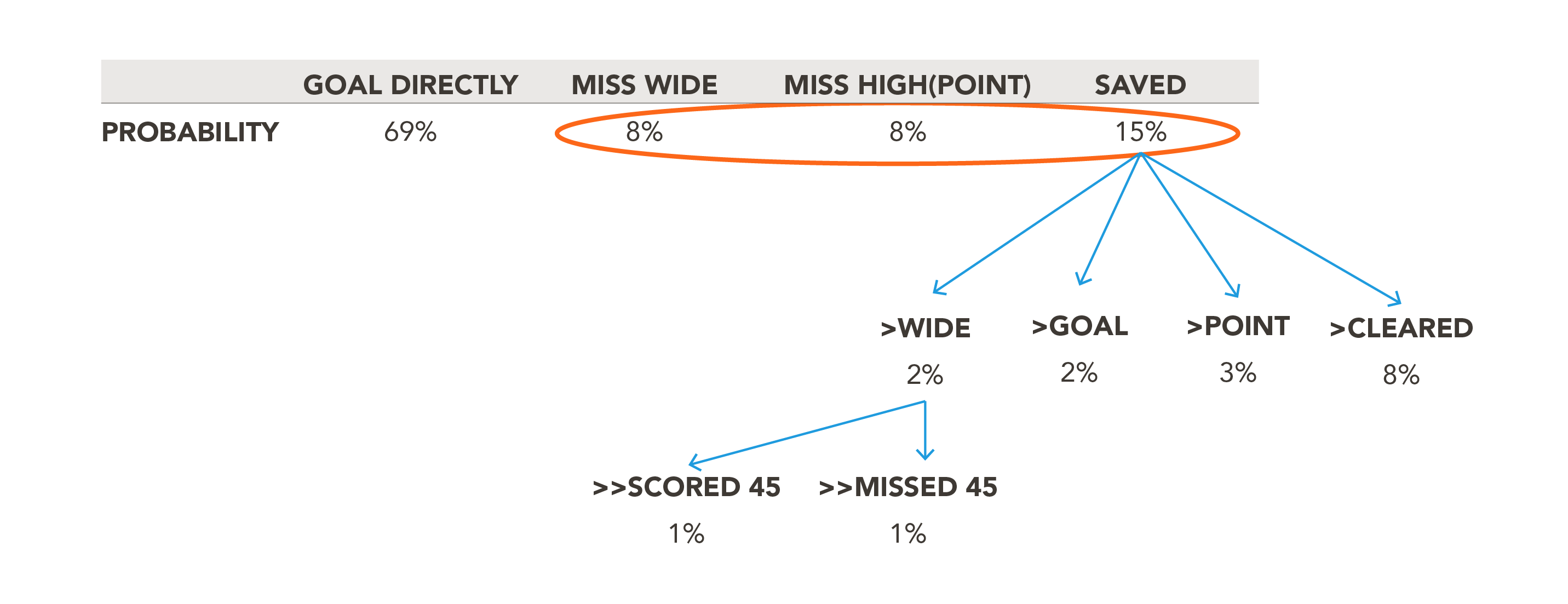
Specifically, the ball may sail over the crossbar (scoring a point), go wide (turning over possession), or be saved by the goalie. This is graphically represented in the table below. If the goalie saves it, there are four different scenarios we’ll consider. We are now operating in the one-level-down area of our graph:
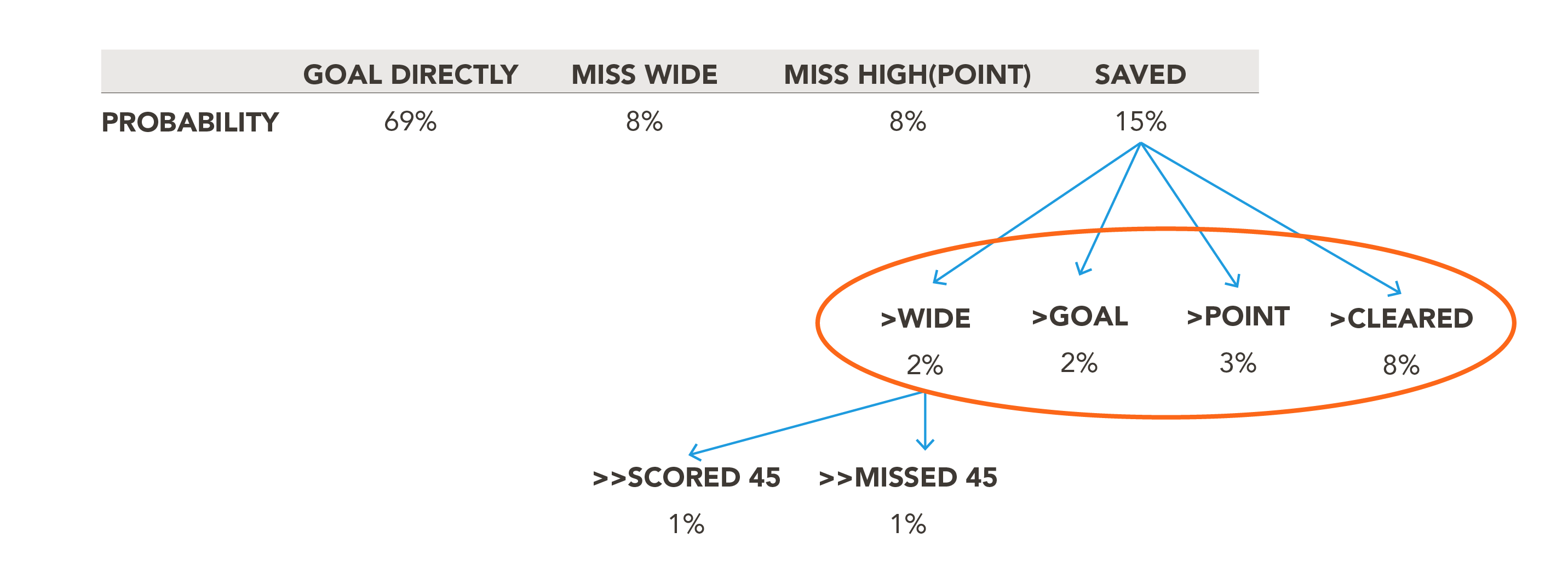
The goalie could push the ball wide, in which case the ball goes out for a “45.” A 45 in Gaelic football is essentially a free kick from 45 metres out. Typically, that gives the player an opportunity to kick for a point. They are successful in this about 50% of the time, so if the goalie was to save it wide, you would still get about half a point on average. Here’s that outcome on the decision/probability graph:
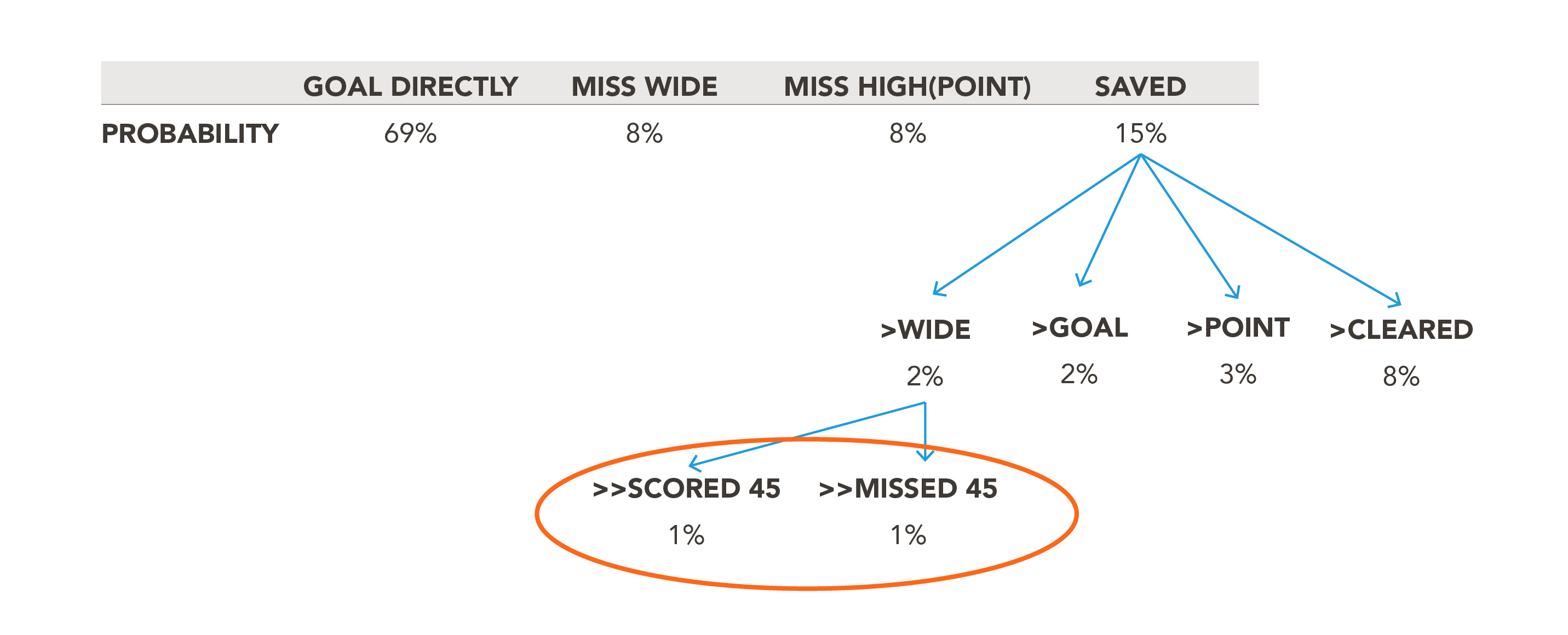
If the goalie makes a save but the ball remains in play, then there will be an ensuing scramble for possession as play does not stop. The remaining three likely outcomes are: a goal for the attacking team, a point for the attacking team, or a clearance by the defending team. It’s going to be hard to get stats on all of these potential outcomes, so we’ll stick our finger in the air a bit here… Given that there’s a scramble for possession, there will be a chance that the attacking team gains possession and scores either a goal or a point. We’ve estimated these very roughly and here are those outcomes on our decision/probability graph:
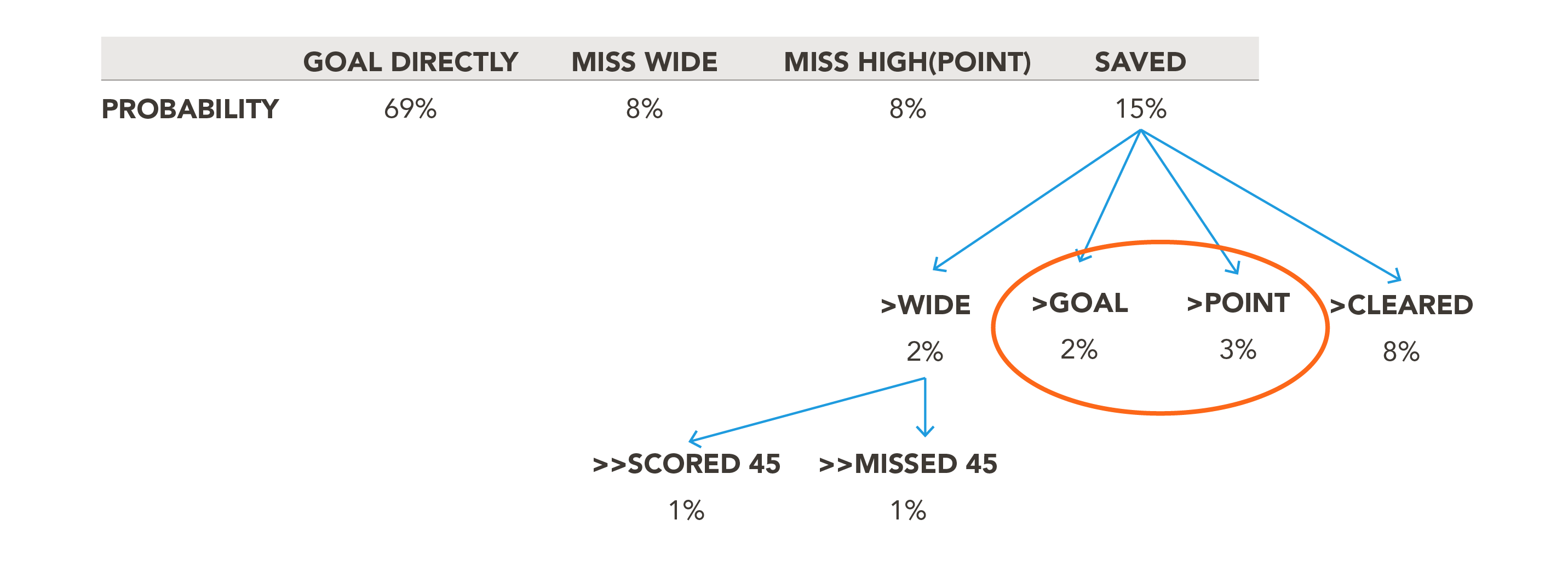
To the 69% chance of scoring a goal directly, we can add the additional expectancy that comes from what happens in the other 31% of cases which we called the indirect set. The indirect set represents cases where the penalty kicker goes for goal and does not score directly – but the ensuing play allows some opportunity for scoring either a goal or point indirectly. Let’s start totalling up all our odds from the various possible outcomes and see what overall expectancy we estimate for the Goal Strategy.
So the chance of scoring a goal directly is 69% and the chance of scoring a goal indirectly is 2% (which happens when the goalie makes a save but the penalty kicker or their teammate manages to score a goal on the rebound). So the total chance of scoring a goal using the Goal Strategy when taking penalties in Gaelic is 69% + 2% which is 71%. The expectancy of this in points is 0.71 times 3 or 2.13 points. (already we can see that the Goal Strategy appears to dominate the Point Strategy which we calculated above as generating 0.95 points).
Let’s look at the chances of scoring a point while using the Goal Strategy. We’ve estimated that the chance of scoring a point directly is 8% – that is the “Miss High” scenario above.((In theory the goalie could also save the goal kick by pushing the ball over the bar for a point, but I think this is unlikely enough that we can ignore it.)) There are also some chances of scoring a point indirectly. There’s a chance that a point will be scored even if the goalie makes a save of the goal shot (on the rebound) – this adds 3% to our odds of scoring a point. And we’re also estimating that there’s a chance of a point being scored where the attacking team has secured a 45 – this adds a further 1% chance of a point. So our overall chance of scoring a point using the Goal Strategy is 8% +3% + 1% which is 12%. The expectancy of this in points is .12 times 1 or .12 points.
So, on average, we expect to score 2.13 points with goals using the Goal Strategy and .12 points with points using the Goal Strategy. That means our total expected scoring using the Goal Strategy is a whopping 2.25 points! Compare that to the estimated 0.95 points that we expect to score using the Point Strategy, and it’s pretty clear that the Goal Strategy easily dominates the Point Strategy for penalty kicking in Gaelic football. Our advice to the Dublin footballers on Sunday will be to go for goal if they should happen to get a penalty.((The odds are clearly only an estimate – however even if a player was to score only 33% of the time rather than 69% the Penalty strategy would still come out ahead on average.)) And Mayo, take your point (from the perspective of a Dubs supporter, obviously)!
One last thing to note – while our calculations show that the Goal Strategy will clearly increase your average total scoring in penalty situations, that doesn’t necessarily mean that it should always be the default choice in every situation. I’ll talk about this a bit more in a later blog post, but just to illustrate this point – imagine that Dublin and Mayo are tied before the last kick of the game and one of the teams gets a penalty. The clearly optimal strategy in this particular instance is to ignore your “average total score,” take the low risk approach of the Point Strategy (95% success rate), and kick the ball over the bar for one point to win the game. So that is one scenario where it is clearly optimal to go for the Point Strategy in spite of the fact that we know in general the Goal Strategy dominates.
If anyone outside of Ireland would like to witness the spectacle that is the All-Ireland GAA football final, it can be streamed live from our national broadcaster RTE for a nominal sum. The game takes place on this coming Sunday 18th September at 3.30pm local time. Up the Dubs!
Update: The original match ended as a draw, so there will be a rematch of the All-Ireland final on Saturday 1st October.




Subscribe Now
Get each new post sent straight to your inbox
We appreciate you taking the time to read our blog and share your feedback. Please be respectful and keep your comments as useful and relevant as possible. We reserve the right to remove comments that contain harassment, offensive language, or are promotional in nature.
Comments are closed.